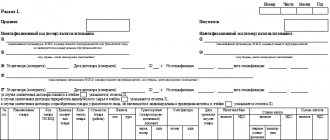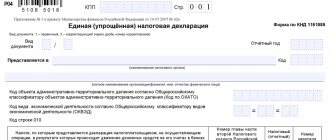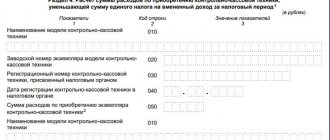Who rents
The report on indirect taxes is not included in the list of mandatory reporting for all taxpayers. The declaration must be provided to a limited number of persons. Here's who submits VAT on indirect taxes:
- importers from the countries of the Eurasian Economic Union - legal entities and individual entrepreneurs;
- payers of indirect taxes - value added tax and excise taxes.
The Eurasian Union includes Russia, Belarus, Kazakhstan, Kyrgyzstan and Armenia. If you are a domestic business and import goods from one of these countries, then you are required to file an indirect tax report. VAT on imported goods is paid at the rates accepted in the Russian Federation (10%, 20%).
Who files the indirect tax return?
Domestic companies and entrepreneurs who import goods from Belarus, Armenia, Kyrgyzstan and Kazakhstan must submit a declaration on indirect taxes - VAT and excise taxes. The form of organization and tax regime do not matter; organizations using the simplified tax system and other special regimes also pay VAT when importing goods. You need to pay tax even if your partner is not a member of the EAEU, but goods are imported from the countries of the Union.
If you have not imported goods or paid lease payments during the month, you do not need to file a declaration. Fill out the declaration for the month in which:
- accepted imported goods for registration;
- It's time for the lease payment.
Due dates
They submit a VAT return only in the month in which the import operations were carried out. If the taxpayer received imported products in the current month or transferred a leasing transfer provided for in the agreement, then the report must be submitted to the regulatory authorities. This condition determines the deadline for submitting the 2021 indirect tax return. If you are working with imported goods in the current month, report by the 20th of the next month. In cases where the month is non-operational, there is no need to submit a declaration.
Failure to meet deadlines will result in sanctions. If you are late with your indirect tax return, you will have to pay a fine. The amount of the penalty is not less than 1000 rubles and not more than 5% of the declared tax payment.
What are indirect taxes?
Indirect taxes are not included in the company's costs, but are added to the sales price of products.
Those. the organization pays them not from its own funds, but from money received from the buyer. Thus, in fact, the tax is paid by the consumer, and the seller acts only as an intermediary between him and the budget. Indirect taxes include VAT and excise taxes. The procedure and timing for payment of indirect taxes on transactions on the territory of the Russian Federation is regulated by Chapters 21 and 22 of the Tax Code of the Russian Federation.
VAT is charged on their goods and services:
- Russian individual entrepreneurs and legal entities that operate on the general taxation system:
- when selling goods in Russia;
- import of goods;
- export of goods - in cases provided by law.
- Russian individual entrepreneurs and legal entities operating under special regimes:
- when selling goods on the territory of Russia - in cases provided for by law;
- import of goods;
- sale of goods abroad - in cases provided for by law.
Separate rules for paying VAT are established for tax agents - business entities paying VAT for their counterparties.
Excise taxes are paid by individual entrepreneurs and legal entities in all taxation systems when selling excisable goods within Russia, importing and, in cases provided for by law, exporting excisable goods abroad.
A special mechanism for collecting VAT and excise taxes is provided for foreign trade transactions within the EAEU (Appendix 18 to the Treaty on the EAEU dated May 29, 2014).
Let us take a closer look at the procedure and timing of payment of indirect taxes in various legal relationships.
Which form to use
In 2021, a tax return for indirect taxes is submitted in the form of KND 1151088, approved by Order of the Federal Tax Service of Russia No. SA-7-3 / [email protected] dated September 27, 2017. This standard consolidates innovations not only in the format of the form (Appendix No. 1), but also in the rules for filling it out (Appendix No. 2). The remaining annexes specify the coding procedure for imported products.
How to file a tax return
The indirect tax return can be submitted in person, sent by registered mail or using the electronic document filing form.
If the declaration is submitted in person, then the date of its receipt is the taxpayer’s visit to the tax authorities. If the document is sent by mail, the date of filing the declaration is the date the letter was sent. In the case when the declaration is submitted electronically, the date of its receipt by the tax inspector is the date of receipt of the receipt for acceptance of the document.
Related articles:
- Land tax for organizations 2021, land tax rate
- How to fill out a water tax return in 2021
- How to fill out a transport tax return in 2021
- Simplified taxation (USN) 2021: income minus expenses, latest changes
- Changes in insurance premiums in 2021
- VAT on export of goods in 2021
- Payroll taxes in 2021, payroll taxation
- Taxes on dividends in 2021
How to fill it out correctly
The rules for filling out excise and VAT returns are similar to those that apply to other tax registers:
- in the report, only those sections that directly relate to the activities of the taxpayer and for which actual transactions were carried out are filled in;
- dashes are placed in all unfilled fields;
- falsification of information is prohibited;
- corrections on paper, the use of a proofreader, going beyond the boundaries of cells, or damaging pages with fastening tools are not allowed;
- the declaration is certified by the manager or other responsible person entrusted with reporting.
The indirect tax report itself consists of a title page and three sections. The front part and the first section are filled out by all excise taxpayers. Information in the remaining blocks is generated as needed. A current example of filling out an indirect tax return for 2021 will help specialists correctly report to regulatory authorities and avoid sanctions for providing incomplete or unreliable information.
Contents of the tax return
The declaration for this type of tax consists of four pages. The title page and Section 1 must be completed by each taxpayer who accepted the imported goods. Section 1 specifies the amount of tax to be paid.
Section 2, which indicates the amount of excise duty on excisable goods, is completed only if the taxpayer has carried out the appropriate actions, that is, imported or accepted excisable goods. Also in this case, an appendix to the document is filled out, in which the tax base for excisable goods is calculated.
How and where to submit
The report is sent to the Federal Tax Service. Submit the form to the authority at the place of registration or location (in this case, code 400 is indicated on the title page). A completed and verified indirect tax declaration is submitted simultaneously with a package of documents certifying the fact of import operations. Here are the forms provided along with the resulting report:
- bank account statement confirming cash flow;
- agreement between importer and supplier;
- all commodity and transport registers (waybills, invoices);
- agency or guarantee agreement;
- 2021 Indirect Tax Statement;
- application for transfer of VAT and excise taxes to the budget;
- other documents as required by the Federal Tax Service.
The declaration is provided in electronic form. All accompanying forms are sent to the inspection in scanned form. If the inspector requires forms for reconciliation, you will have to bring the original documents legalizing the import of goods to the Federal Tax Service office.
Filling out section 2 of the declaration
Section 2 includes indicators of the amounts of excise tax payable to the budget, according to the taxpayer. When filling it out, it is necessary to reflect the taxpayer’s INN and KPP, as well as the serial number of the page.
Line 010 displays the OKATO code.
On line 020 - the corresponding BCC to which the excise tax amount is credited. When filling out page 030, the total amount of excise tax to be paid to the budget is indicated. If the taxpayer calculates excise tax amounts for several types of excisable goods, the excise tax amounts for which are subject to credit to different BCCs, the number of sheets of section. 2 must correspond to the number of BCCs.
Column 040 indicates the code of the type of excisable goods in accordance with the Directory of Codes of Types of Excise Goods (SKPT), in gr. 050 - code of the unit of measurement of the tax base in accordance with the All-Russian Classifier of Units of Measurement (OKEY). Column 060 reflects the tax base determined in accordance with clause 4 of Art. 2 of the Protocol, according to which the tax base for excise taxes is the volume, quantity (other indicators) of imported excisable goods in physical terms, in respect of which fixed (specific) excise tax rates are established, or the cost of imported excisable goods, in respect of which ad valorem excise tax rates are established.
The Directory of Codes of Types of Excise Goods (SCPT) to Order of the Ministry of Finance of Russia dated July 7, 2010 N 69n has not been approved. Before its approval, we recommend that you follow the Directory of Codes of Excise Goods (DKPT), specified in Appendix No. 3 to the Procedure for filling out a tax return for indirect taxes (value added tax and excise taxes) when importing goods into the territory of the Russian Federation from the territory of the Republic of Belarus, approved. By Order of the Ministry of Finance of Russia dated November 27, 2006 N 153n.
The Directory of units of measurement of the tax base of excisable goods (OKEI) to Order No. 69n dated 07/07/2010 has not been approved. Before its approval, we recommend that you follow the Directory of units of measurement of the tax base of excisable goods, specified in Appendix No. 4 to the Procedure for filling out a tax return for indirect taxes.
The tax base for calculating excise taxes is determined on the date of registration by the taxpayer of imported excisable goods (but no later than the period established by the legislation of the member state of the Customs Union into whose territory the excisable goods were imported).
The volume of imported excisable goods is reflected:
— in liters for ethyl alcohol, alcohol-containing products, alcoholic beverages and beer. For ethyl alcohol, alcohol-containing products and alcoholic products, the tax base (volume of imported products) is reflected in terms of anhydrous ethyl alcohol.
The tax base for anhydrous ethyl alcohol is recalculated in the Appendix to the declaration;
— in horsepower (1 hp = 0.75 kW) for cars and motorcycles. To determine the engine power in horsepower, the value of the indicated indicator in kilowatts should be divided by 0.75. The total engine power of passenger cars and motorcycles for each type of excisable goods is determined in the Appendix to the declaration;
— in tons for petroleum products.
Number of lines in gr. 040, 050, 060 must correspond to the number of types of excisable goods, the calculated amounts of excise duty on which are credited to one BCC indicated on page 020.
Indirect taxes on import transactions
The importation of valuables into the territory of the Customs Union of the Russian Federation is the reason for the calculation and payment of indirect taxes. You need to pay to the country whose customs authority issues the goods and materials:
- When importing goods from countries not included in the list of members of the customs union, the added tax must be paid in the Russian Federation, since the release will be carried out by the Russian customs authority, and the tax is transferred to this authority;
- When importing valuables from EAEU states, the tax must be transferred to the tax office, where the owner of the valuables (buyer) is registered. The EAEU includes Belarus, the Russian Federation, Kazakhstan, Kyrgyzstan, and Armenia. Tax obligations in relation to the payment of VAT are provided for all persons, regardless of the taxation regime they apply and the availability of exemptions from payment (exceptions are listed in paragraph 6 of Article 72 of the Treaty on the EAEU).
Payment procedure
The responsibility to remit the added tax falls on the declarant of goods, that is, the buyer.
To make the right decision regarding the need to transfer tax on imported valuables, its amount and place of payment, you need to decide on the following points:
- Are imported goods exempt from VAT?
- What customs procedure is used for imported valuables;
- What VAT rate should be applied;
- What is the formula for calculating the tax to be transferred?
VAT for trade transactions within Russia: payment procedure and terms
Individual entrepreneurs and legal entities on OSN pay VAT until the 25th day of each of the 3 months following the reporting quarter in which trade transactions subject to this tax were carried out in Russia (that is, sales of goods subject to VAT). At the same time, in each of the 3 months following the reporting quarter, 1/3 of the calculated VAT for the quarter is transferred to the budget (clause 1 of Article 174 of the Tax Code of the Russian Federation).
For example, if for the 1st quarter of 2021 a company calculated VAT in the amount of 150,000 rubles, then it must pay:
- until 04/27/2020 - 50,000 rubles;
- 05.25.2020 - 50,000 rub.;
- 06.25.2020 — 50,000 rub.
Read about how to fill out and submit a VAT return in our material.
Individual entrepreneurs and legal entities under special regimes pay VAT only if, on their own initiative, they generate for a Russian counterparty an invoice with a separate tax or a universal transfer document with attribute 1. Payment of the tax is carried out by the 25th day of the month following the quarter in which an invoice has been issued. In this case, the calculated VAT is paid to the budget in the full amount, which is not divisible by 3.
Let us now consider the procedure for paying indirect tax, represented by VAT, when importing goods, works and services into Russia.






